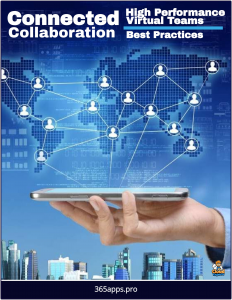 In today’s fast-paced, hyper-competitive world, collaboration alone is no longer enough to ensure a team’s success.
In today’s fast-paced, hyper-competitive world, collaboration alone is no longer enough to ensure a team’s success.
While working together is a foundational element of any functional group, elite teams—those that consistently outperform expectations and deliver extraordinary results—go far beyond mere cooperation.
They tap into a deeper set of principles, practices, and mindsets that elevate them from good to exceptional.
This guide explores the secrets to building such high-performance teams, drawing on proven strategies and insights that transcend traditional teamwork.
Virtual Collaboration
Virtual collaboration refers to the process of working together with others to achieve shared goals, complete tasks, or solve problems without being physically present in the same location.
It relies on digital tools and technologies—like Microsoft Teams, Zoom, or Slack—to bridge geographical gaps, enabling seamless communication, coordination, and productivity among team members who may be scattered across cities, countries, or even continents.
At its core, virtual collaboration mimics the dynamics of in-person teamwork but adapts them to an online environment. It encompasses real-time interactions (like video calls or instant messaging), asynchronous efforts (such as shared documents or email threads), and the use of centralized platforms to store resources, track progress, and maintain transparency.
For example, a designer in Tokyo might edit a file in Teams, while a marketer in New York provides feedback via chat, and a manager in London reviews it—all without leaving their respective time zones.
What makes virtual collaboration powerful is its ability to connect diverse talent, eliminate travel costs, and offer flexibility. However, it also comes with challenges: time zone differences, tech glitches, or the risk of miscommunication due to the lack of face-to-face cues.
Effective virtual collaboration hinges on clear communication, reliable tools, and intentional strategies—like setting expectations, leveraging features such as shared channels or task boards, and fostering a sense of team unity despite the distance. In essence, it’s about harnessing technology to make “working apart” feel like “working together.”
The Myth of Collaboration as the Endgame
Collaboration is often heralded as the gold standard for team dynamics: get people in a room, encourage communication, and watch the magic happen.
But elite teams understand that collaboration is just the starting point. It’s the baseline, not the finish line. Too often, teams get stuck in a cycle of endless meetings, consensus-seeking, and watered-down decisions that prioritize harmony over impact. High-performance teams, by contrast, harness collaboration as a tool to fuel something greater—alignment, accountability, and execution.
The secret lies in recognizing that collaboration without purpose is noise. Elite teams don’t just work together; they work toward a shared vision with relentless focus and clarity. This requires a shift from process-driven teamwork to outcome-driven performance.
Secret 1: Obsess Over Clarity of Purpose
The first hallmark of an elite team is an unshakable understanding of why they exist. Every member knows the team’s mission, how it fits into the broader organizational goals, and what success looks like in concrete terms. This clarity isn’t a vague mission statement hanging on the wall—it’s a living, breathing directive that guides every decision and action.
Leaders of high-performance teams invest time upfront to define and communicate this purpose. They eliminate ambiguity by setting specific, measurable goals and ensuring every team member understands their role in achieving them. For example, a sales team might not just aim to “increase revenue” but to “grow recurring revenue by 25% in Q3 by targeting mid-market clients in the tech sector.” This precision aligns effort and minimizes wasted energy.
Secret 2: Recruit for Complementary Strengths, Not Conformity
Elite teams aren’t built by assembling a group of like-minded individuals who nod in agreement. They thrive on diversity—not just in demographics, but in skills, perspectives, and problem-solving approaches. The secret is to recruit team members whose strengths complement one another, creating a whole that’s greater than the sum of its parts.
Consider a software development team: a visionary product manager, a meticulous coder, a creative UI designer, and a data-driven QA engineer bring different lenses to the table. The magic happens when these differences are leveraged intentionally, not suppressed in the name of “team fit.” Leaders must resist the urge to hire clones of themselves and instead seek out individuals who fill gaps and challenge the status quo.
Secret 3: Foster a Culture of Radical Accountability
Collaboration often falters when accountability is diffuse—when “everyone” is responsible, no one truly is. Elite teams operate differently. They establish a culture where every member owns their piece of the puzzle and is empowered to call out when others fall short. This isn’t about blame; it’s about trust and mutual reliance.
One practical approach is to implement clear ownership frameworks, such as the RACI model (Responsible, Accountable, Consulted, Informed), to delineate roles.
But beyond tools, radical accountability requires psychological safety—a term popularized by Google’s Project Aristotle. Team members must feel safe to take risks, admit mistakes, and hold each other to high standards without fear of retribution. Leaders set the tone by modeling this behavior, owning their missteps publicly and celebrating those who do the same.
Secret 4: Master the Art of Constructive Conflict
High-performance teams don’t shy away from disagreement; they embrace it as a catalyst for innovation. The secret is to channel conflict constructively, ensuring it’s about ideas, not egos. This requires team members to develop emotional intelligence and leaders to facilitate debates that stay focused on the goal.
For instance, Amazon’s leadership principle of “Disagree and Commit” exemplifies this approach. Team members are encouraged to voice dissent during decision-making, but once a path is chosen, everyone commits fully to its execution. This balance prevents paralysis while harnessing the power of diverse viewpoints. Elite teams train themselves to argue well—fact-based, respectful, and solution-oriented—turning tension into progress.
Secret 5: Prioritize Speed Through Trust
Speed is a competitive advantage, and elite teams move fast because they trust each other implicitly. Trust isn’t built through team-building exercises alone (though those can help); it’s forged in the crucible of consistent delivery and reliability. When team members know their colleagues will do what they say, bureaucracy melts away, and decisions happen at lightning speed.
To accelerate trust, leaders can encourage small, early wins—quick projects that build confidence in the team’s ability to execute. Transparency also plays a key role: sharing progress, setbacks, and feedback openly keeps everyone on the same page. Over time, this trust becomes the grease that keeps the team’s engine humming.
Secret 6: Measure What Matters—and Act on It
Elite teams don’t drown in data; they zero in on the metrics that drive their success and use them to course-correct in real time. This requires discipline to avoid vanity metrics (e.g., hours worked) and focus on outcomes (e.g., customer satisfaction scores or product launch timelines).
Regular check-ins, like weekly stand-ups or post-mortems after major milestones, keep the team aligned and responsive. The secret isn’t just tracking these metrics but acting decisively when they signal trouble—whether that means reallocating resources, rethinking strategy, or doubling down on what’s working.
Secret 7: Celebrate Wins, Learn from Losses
Finally, elite teams sustain their momentum by balancing recognition with reflection. Celebrating victories—big and small—reinforces the behaviors that lead to success and boosts morale. Equally important, they treat setbacks as learning opportunities, not failures. After a loss, they ask: What worked? What didn’t? How do we adapt?
This dual focus keeps the team resilient and forward-looking. A tech startup, for example, might toast a successful product launch with a team dinner while dissecting a failed feature rollout in a blame-free retrospective the next day. Both practices fuel continuous improvement.
Beyond Collaboration: The Elite Advantage
Building a high-performance team isn’t about perfecting collaboration—it’s about transcending it. By obsessing over purpose, leveraging complementary strengths, fostering accountability, embracing conflict, building trust, measuring wisely, and balancing celebration with learning, teams can unlock their elite potential.
These secrets aren’t quick fixes; they demand intention, discipline, and leadership. But for those willing to go beyond the basics, the reward is a team that doesn’t just succeed—it dominates. In a world where mediocrity is the norm, elite teams stand out not because they work together, but because they win together. That’s the true secret to their success.



